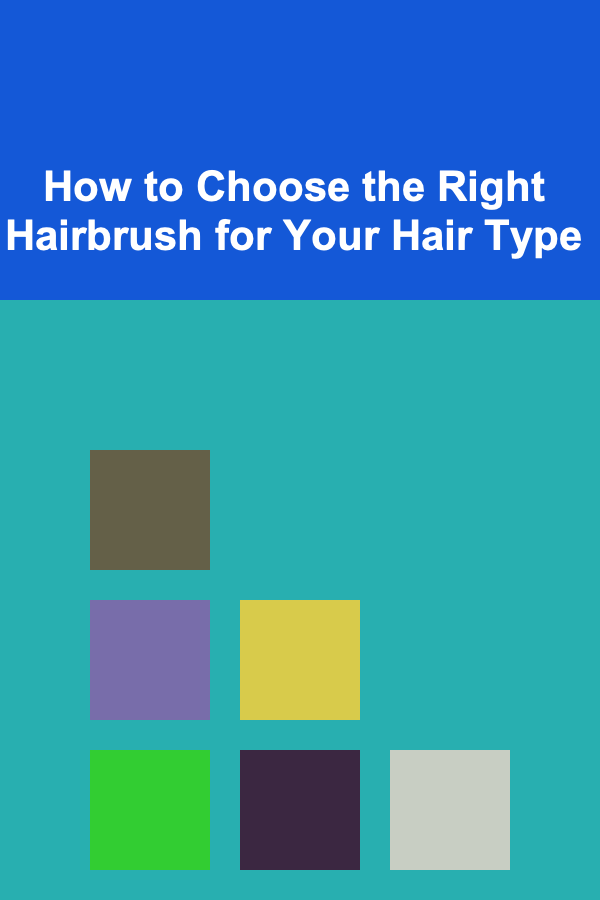
How to Choose the Right Hairbrush for Your Hair Type
ebook include PDF & Audio bundle (Micro Guide)
$12.99$10.99
Limited Time Offer! Order within the next:

Choosing the right hairbrush is far more than a simple grooming decision; it's an investment in the health, appearance, and manageability of your hair. While it might seem trivial, using the wrong brush can lead to breakage, frizz, scalp irritation, and even hair loss over time. Conversely, the right brush can detangle gently, stimulate the scalp for increased blood flow and hair growth, distribute natural oils for shine, and style your hair with ease. This comprehensive guide will delve into the nuances of hair types, brush materials, shapes, and bristle types, equipping you with the knowledge to make an informed decision that will transform your hair care routine.
Understanding Your Hair Type: The Foundation of Brush Selection
Before diving into the world of hairbrushes, it's crucial to accurately identify your hair type. Hair type is determined by several factors, including:
- Hair Texture: Refers to the thickness or diameter of individual hair strands. Hair texture is categorized as fine, medium, or coarse.
- Hair Density: Describes the number of hair strands per square inch of your scalp. Density is classified as thin, medium, or thick.
- Hair Porosity: Indicates the hair's ability to absorb and retain moisture. Porosity levels are low, medium, or high.
- Hair Curl Pattern: Ranges from straight (Type 1) to wavy (Type 2), curly (Type 3), and coily (Type 4). Each curl pattern has subcategories (a, b, and c) that further define the tightness of the curl.
Understanding these characteristics is paramount because different brushes are designed to address the specific needs of each hair type. Let's explore how each hair type influences brush selection:
Fine Hair
Fine hair is delicate and prone to breakage. It requires gentle handling and brushes that won't weigh it down. Look for brushes with soft bristles that won't cause damage or split ends.
- Ideal Brushes: Boar bristle brushes (especially a blend of boar and nylon), soft-bristled paddle brushes, and wide-tooth combs are excellent choices for fine hair.
- Why These Work: Boar bristles distribute natural oils from the scalp down the hair shaft, adding shine and preventing dryness. They are also gentle enough to detangle without causing breakage. Soft-bristled paddle brushes smooth the hair without pulling or snagging. Wide-tooth combs are essential for detangling wet or dry hair, minimizing damage.
- Brushes to Avoid: Brushes with stiff bristles, metal bristles, or those designed for thick hair can be too harsh and cause breakage. Round brushes with metal barrels that heat up quickly can also damage fine hair.
Medium Hair
Medium hair offers more versatility in brush selection, but it still requires careful consideration. It's generally more resilient than fine hair but can still be susceptible to damage if treated roughly.
- Ideal Brushes: A combination of boar and nylon bristle brushes, paddle brushes with cushioned bases, and round brushes (with appropriate barrel size for styling) are suitable options.
- Why These Work: The combination of boar and nylon bristles provides a good balance of detangling and oil distribution. Paddle brushes with cushioned bases are gentle on the scalp and minimize pulling. Round brushes can be used for styling and adding volume.
- Brushes to Avoid: While medium hair is more resilient, avoid brushes with excessively stiff bristles or those designed for extremely thick hair, as they can still cause unnecessary stress.
Thick Hair
Thick hair is characterized by a high density of hair strands, making it more challenging to manage and style. Brushes need to be strong enough to penetrate the hair and effectively detangle and smooth it.
- Ideal Brushes: Paddle brushes with stiff nylon or mixed bristles, vented brushes, and wide-tooth combs are well-suited for thick hair.
- Why These Work: Stiff bristles can effectively detangle thick hair without bending or breaking. Paddle brushes with a wide base cover a large surface area, making the brushing process more efficient. Vented brushes allow airflow, which helps to dry hair faster during blow-drying. Wide-tooth combs are essential for detangling wet hair and preventing breakage.
- Brushes to Avoid: Brushes with soft bristles are unlikely to penetrate thick hair effectively. Small, flimsy brushes will be ineffective and may even break.
Straight Hair
Straight hair is generally the easiest to brush and style. The primary goals are to maintain its smoothness, shine, and prevent static.
- Ideal Brushes: Paddle brushes, boar bristle brushes, and round brushes are all good options for straight hair.
- Why These Work: Paddle brushes smooth the hair and distribute natural oils. Boar bristle brushes add shine and prevent frizz. Round brushes can be used to add volume and create curls or waves.
- Brushes to Avoid: While straight hair is relatively forgiving, avoid brushes with excessively sharp or stiff bristles that can scratch the scalp or create static.
Wavy Hair
Wavy hair can range from loose, beachy waves to more defined S-shaped waves. The key is to maintain the wave pattern without creating frizz or breakage.
- Ideal Brushes: Wide-tooth combs, paddle brushes with flexible bristles, and denman brushes are good choices for wavy hair.
- Why These Work: Wide-tooth combs gently detangle wet or dry hair without disrupting the wave pattern. Paddle brushes with flexible bristles smooth the hair without pulling or causing frizz. Denman brushes can be used to define and enhance the wave pattern.
- Brushes to Avoid: Brushes with stiff bristles or those that are too small can disrupt the wave pattern and create frizz.
Curly Hair
Curly hair (Type 3) is prone to dryness, frizz, and breakage. It requires gentle handling and brushes that can detangle without disrupting the curl pattern.
- Ideal Brushes: Wide-tooth combs, denman brushes (with adjustable rows), and tangle teezer brushes are excellent for curly hair. Detangling should primarily be done when the hair is wet and conditioned.
- Why These Work: Wide-tooth combs detangle gently and minimize breakage. Denman brushes help to define and shape curls, and the adjustable rows allow for customization based on curl type. Tangle Teezer brushes are designed to detangle without pulling or snagging.
- Brushes to Avoid: Brushes with stiff bristles, small brushes, and those designed for straight hair can disrupt the curl pattern and cause frizz and breakage. Avoid brushing curly hair when it's dry, as this can lead to frizz and damage.
Coily Hair
Coily hair (Type 4) is the most fragile hair type and requires extreme care. It's prone to dryness, shrinkage, and breakage. Detangling should be done very gently on wet, well-conditioned hair.
- Ideal Brushes: Wide-tooth combs, detangling brushes designed for textured hair, and finger detangling are the best options for coily hair.
- Why These Work: Wide-tooth combs detangle gently and minimize breakage. Detangling brushes designed for textured hair have flexible bristles that glide through the hair. Finger detangling is the gentlest method and allows you to feel for knots and tangles before pulling.
- Brushes to Avoid: Avoid brushes with stiff bristles, small brushes, and those that are not specifically designed for textured hair. Aggressive brushing can lead to significant breakage and damage.
Understanding Brush Materials: Bristles, Body, and Handle
Beyond hair type, the materials used in a hairbrush play a significant role in its performance and suitability for your hair. Let's explore the common materials used in hairbrushes:
Bristle Materials
- Boar Bristle: Derived from wild boars, boar bristles are known for their ability to distribute natural oils (sebum) from the scalp down the hair shaft. This helps to moisturize the hair, add shine, and reduce frizz. They are gentle on the scalp and can help to stimulate blood flow, promoting hair growth. However, boar bristles are not ideal for thick or very textured hair, as they may not penetrate the hair effectively. They are also more difficult to clean.
- Nylon Bristle: Nylon bristles are synthetic and come in varying degrees of stiffness. They are more durable than boar bristles and are better suited for thick or coarse hair. Nylon bristles can effectively detangle hair and can be used on wet or dry hair. They don't distribute natural oils as effectively as boar bristles, but they are easier to clean.
- Mixed Bristle (Boar and Nylon): These brushes combine the benefits of both boar and nylon bristles. The nylon bristles help to detangle the hair, while the boar bristles distribute natural oils and add shine. This is a versatile option that works well for many hair types, especially fine to medium hair.
- Metal Bristle: Metal bristles are generally not recommended for everyday use, as they can be harsh on the scalp and cause breakage. They are sometimes used in styling brushes for creating specific looks, but they should be used with caution.
- Plastic Bristle: Inexpensive and durable, plastic bristles are found in many mass-market brushes. They are easy to clean but often lack the gentleness and beneficial properties of boar or nylon. Look for plastic bristles with rounded tips to minimize scalp irritation.
Brush Body Materials
- Wood: Wooden brush bodies are often more durable and aesthetically pleasing. They can also be more eco-friendly. However, they may be more expensive and require more care to prevent damage from moisture.
- Plastic: Plastic brush bodies are lightweight, durable, and affordable. They are also easy to clean. However, they may not be as aesthetically pleasing or as environmentally friendly as wooden brushes.
- Metal: Metal brush bodies are often used in round brushes for blow-drying. The metal heats up quickly, which can help to speed up the drying process. However, it's important to use caution when using metal brushes, as they can damage the hair if they get too hot.
Handle Materials
- Wood: Wooden handles are comfortable to hold and can provide a good grip. They are also aesthetically pleasing.
- Plastic: Plastic handles are lightweight, durable, and affordable. They are also easy to clean. Look for handles with ergonomic designs for comfortable use.
- Rubber: Rubber handles provide a non-slip grip, which is especially useful when brushing wet hair.
Brush Shapes and Their Purposes
The shape of a hairbrush is just as important as the bristle type and materials. Different shapes are designed for different purposes, from detangling to styling.
- Paddle Brush: Paddle brushes are large, flat brushes with a wide rectangular or oval head. They are ideal for detangling long hair, smoothing the hair, and adding shine. The wide surface area helps to cover a large section of hair quickly. They are also good for stimulating the scalp.
- Round Brush: Round brushes are used for styling hair, adding volume, and creating curls or waves. They come in various sizes, and the size you choose will depend on the length and thickness of your hair, as well as the type of style you want to create. Smaller round brushes are good for creating tight curls, while larger round brushes are better for adding volume and creating loose waves.
- Vented Brush: Vented brushes have holes in the brush head that allow air to circulate freely. This helps to speed up the drying process when blow-drying hair. They are also good for detangling thick hair.
- Detangling Brush: Detangling brushes are specifically designed to gently detangle hair without pulling or snagging. They typically have flexible bristles that bend and flex to avoid breakage.
- Cushion Brush: Cushion brushes have a cushioned base that helps to absorb shock and prevent damage to the scalp. They are good for all hair types and are especially beneficial for people with sensitive scalps.
- Teasing Brush: Teasing brushes are designed with tightly packed bristles, often made of boar or nylon, used to create volume at the roots by backcombing the hair. They are typically small and have a pointed end for sectioning.
- Denman Brush: A Denman brush is a styling brush known for its removable rows of pins. This feature allows you to customize the brush to your specific curl pattern and desired definition. It's a popular choice for defining curls and waves.
Key Considerations When Choosing a Hairbrush
Beyond hair type and brush characteristics, several other factors should influence your hairbrush selection:
- Wet or Dry Hair: Certain brushes are better suited for wet hair than others. Wide-tooth combs and detangling brushes are generally recommended for detangling wet hair, as wet hair is more fragile and prone to breakage. Avoid using brushes with stiff bristles on wet hair.
- Scalp Sensitivity: If you have a sensitive scalp, choose a brush with soft bristles and a cushioned base. Avoid brushes with sharp or stiff bristles that can irritate the scalp.
- Styling Goals: Consider the hairstyles you want to create. If you want to add volume, a round brush is a good choice. If you want to smooth the hair, a paddle brush is a better option.
- Budget: Hairbrushes range in price from inexpensive plastic brushes to high-end boar bristle brushes. Set a budget before you start shopping and stick to it. While a more expensive brush may offer better performance or durability, there are many affordable options that can still be effective.
- Maintenance: Consider how easy the brush is to clean. Brushes with natural bristles can be more difficult to clean than brushes with synthetic bristles. Regular cleaning is essential to prevent the buildup of dirt, oil, and hair products.
Tips for Maintaining Your Hairbrush
Proper maintenance is essential for extending the lifespan of your hairbrush and keeping your hair healthy.
- Remove Hair Regularly: After each use, remove any loose hair from the brush. You can use your fingers or a comb to remove the hair.
- Wash Regularly: Wash your hairbrush every few weeks with warm water and a mild shampoo. Avoid soaking wooden brushes, as this can damage the wood.
- Dry Thoroughly: After washing, allow the brush to dry completely before using it again. This will prevent the growth of mold and bacteria.
- Replace When Necessary: Replace your hairbrush every 6-12 months, or sooner if the bristles become damaged or worn.
Pro Tip: Invest in a brush cleaning tool. These inexpensive tools have small prongs that easily grab and remove hair from the bristles of your brush, making the cleaning process much easier and more efficient.
Conclusion: The Path to Healthy, Beautiful Hair
Choosing the right hairbrush is a crucial step in achieving healthy, beautiful hair. By understanding your hair type, considering the materials and shapes of different brushes, and maintaining your brush properly, you can significantly improve the health and appearance of your hair. Don't underestimate the power of this seemingly simple tool. Investing in the right brush is an investment in the long-term health and beauty of your hair.
Experiment with different brushes to find the ones that work best for you and your hair type. Remember that what works for one person may not work for another. Pay attention to how your hair feels after brushing and adjust your brush selection accordingly. With a little research and experimentation, you can find the perfect brushes to keep your hair looking its best.
This guide provides general information and recommendations. It's always best to consult with a professional hairstylist for personalized advice tailored to your specific hair needs and concerns. The information provided is not intended to be a substitute for professional medical advice, diagnosis, or treatment. Always seek the advice of your physician or other qualified health provider with any questions you may have regarding a medical condition.

How to Build a Checklist for Deciding Between New vs. Pre-Owned Homes
Read More
How to Transition from Student to Professional Finances
Read More
Thrifty Party Planning Tips: Saving Money Without Sacrificing Fun
Read More
Choosing the Best Sleeping Pad for Comfort: A Comprehensive Guide
Read More
How to Improve Your Credit Score
Read More
10 Tips for Measuring ROI on Your Native Advertising Efforts
Read MoreOther Products

How to Build a Checklist for Deciding Between New vs. Pre-Owned Homes
Read More
How to Transition from Student to Professional Finances
Read More
Thrifty Party Planning Tips: Saving Money Without Sacrificing Fun
Read More
Choosing the Best Sleeping Pad for Comfort: A Comprehensive Guide
Read More
How to Improve Your Credit Score
Read More